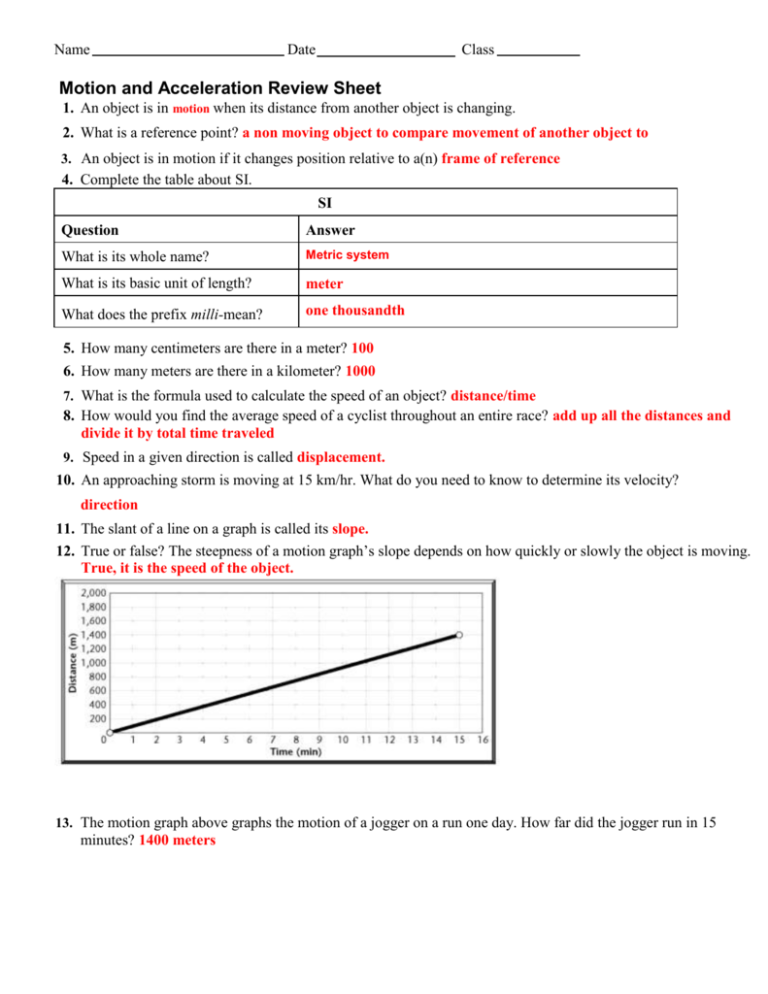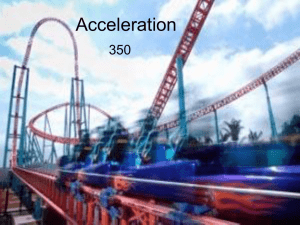New Title - TeacherWeb
advertisement

Name Date Class Motion and Acceleration Review Sheet 1. An object is in motion when its distance from another object is changing. 2. What is a reference point? a non moving object to compare movement of another object to 3. An object is in motion if it changes position relative to a(n) frame of reference 4. Complete the table about SI. SI Question Answer What is its whole name? Metric system What is its basic unit of length? meter What does the prefix milli-mean? one thousandth 5. How many centimeters are there in a meter? 100 6. How many meters are there in a kilometer? 1000 7. What is the formula used to calculate the speed of an object? distance/time 8. How would you find the average speed of a cyclist throughout an entire race? add up all the distances and divide it by total time traveled 9. Speed in a given direction is called displacement. 10. An approaching storm is moving at 15 km/hr. What do you need to know to determine its velocity? direction 11. The slant of a line on a graph is called its slope. 12. True or false? The steepness of a motion graph’s slope depends on how quickly or slowly the object is moving. True, it is the speed of the object. 13. The motion graph above graphs the motion of a jogger on a run one day. How far did the jogger run in 15 minutes? 1400 meters 14. The motion graph above also shows the motion of a jogger on a run one day. The middle segment is horizontal. What does that tell you about the jogger’s progress between minute 6 and minute 8? the jogger was not moving Acceleration 1. What is acceleration? the change in speed/velocity over time 2. Acceleration involves a change in either speed/velocity or direction. 3. Any time the speed of an object increases, the object experiences acceleration. 4. True or false? Acceleration refers to increasing speed, decreasing speed, or changing direction. True 5. Deceleration is another word for negative acceleration . 6. True or false? An object can be accelerating even if its speed is constant. True, if its direction is changing 7. Circle the letter of each sentence that describes an example of acceleration. a. A car follows a gentle curve in the road. b. A batter swings a bat to hit a ball. c. A truck parked on a hill doesn’t move all day. d. A runner slows down after finishing a race. 8. The moon revolves around Earth at a fairly constant speed. Is the moon accelerating? Yes, because it is constantly changing direction 9. Use the table below to compare and contrast the meanings of acceleration. In Everyday Language Acceleration In Scientific Language Speeding up Increasing speed Slowing down Decreasing speed Turning Changing direction 10. What must you calculate to determine the acceleration of an object? Velocity (final – initial) & total time 11. What is the formula you use to determine the acceleration of an object moving in a straight line? vf – vi time 12. True or false? To calculate the acceleration of an automobile, you must first subtract the final speed from the initial speed. False, you subtract the initial speed from the final speed 13. Displacement and velocity are examples of vectors because they have both magnitude and direction. 14. V d is the equation that defines average speed. t 15. Instantaneous acceleration is how fast a velocity is changing at a specific instant. 16. The motion of an object looks different to observers in different frames of reference. 17. The SI unit for measuring distance is the meter. 18. The direction and length of a straight line from the starting point to the ending point of an object’s motion is displacement. 19. The sum of two or more vectors is called the resultant vector. 20. Speed is measured in units of m/s, mph, km/h. 21. A car’s speedometer measures instantaneous speed. 22. Because its direction is always changing, an object moving in a circular path experiences a constant change in velocity. 23. A moving object does not accelerate if its velocity remains constant. 24. Freely falling objects accelerate at 9.8 m/s2 because the force of gravity acts on them. 25. The acceleration of a moving object is calculated by dividing the change in velocity by the time over which the change occurs. 26. What is the SI unit best suited for measuring the height of a building? meters 27. A child rolls a ball 4 m across a room. The ball hits the wall and rolls halfway back toward the child. Using vector addition, calculate the ball’s displacement. 2 meters away from the child 28. Which is the most suitable SI unit for expressing the speed of a race car? km/h 29. Bus A travels 300 m in 12 s. Bus B travels 200 m in 12 s. Both vehicles travel at constant speed. How do the distance-time graphs for these two speeds differ? Bus A has a steeper slope than Bus B. Bus A has a faster speed. 30. What types of changes in motion cause acceleration? speed and direction changes or both 31. Distance is a measure of length. What information does displacement give in addition to distance? Direction 32. What are two types of speed that can be used to describe the motion of a car driving on the highway? Average and instantaneous speed 33. What is the significance of the slope in a distance-time graph? speed 34. What information does the slope of a speed-time graph provide? Acceleration – speeding up, slowing down, or periods of rest STUDY GUIDE Understand frame of reference – what is moving and what is not SI units of measurement – cm, m, km – what distance is each used to measure Be able to measure distance and displacement of a trip Be able to explain how a round trip can have a 0 displacement Be able to calculate speed (distance/time) and average speed (total distance/total time) Be able to calculate time knowing speed and distance Be able to determine speed (slope), acceleration, and standstill from a distance vs. time graph Be able to explain how velocity is different from speed Be able to add vectors for changing speed, direction, and velocity Be able to calculate acceleration (final speed – initial speed/time) for changing speed, direction or both Be able to determine acceleration (slope) from a velocity/speed vs. time graph Understand that an instantaneous acceleration can be positive, negative, or zero Be able to explain how instantaneous is different from average speed/acceleration Be able to explain free fall (constant acceleration due to gravity)









